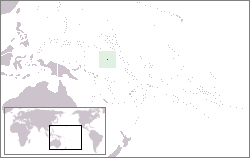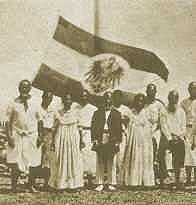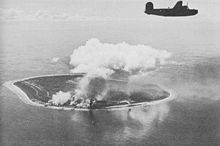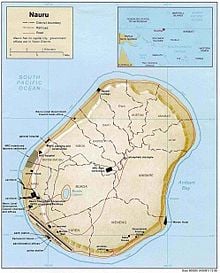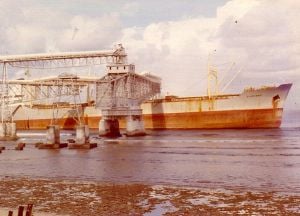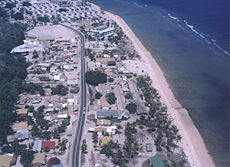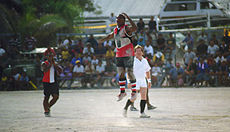Nauru
- For other uses, see Nauru (disambiguation).
| Ripublik Naoero Republic of Nauru |
||||||
|---|---|---|---|---|---|---|
|
||||||
| Motto: God's Will First | ||||||
| Anthem: Nauru Bwiema |
||||||
| Capital | Yaren1 | |||||
| Largest city | Yaren | |||||
| Official languages | English, Nauruan | |||||
| Government | Republic | |||||
| - | President | Ludwig Scotty | ||||
| Independence | ||||||
| - | from the Australia, NZ, and UK-administered UN trusteeship | 31 January 1968 | ||||
| Area | ||||||
| - | Total | 21 km² (228th) 8.1 sq mi |
||||
| - | Water (%) | Negligible | ||||
| Population | ||||||
| - | July 2005 estimate | 13,005 (220th) | ||||
| GDP (PPP) | 2005 estimate | |||||
| - | Total | $60 million (224th) | ||||
| - | Per capita | $5,000 (2005 est.) (132nd) | ||||
| Currency | Australian dollar (AUD) |
|||||
| Time zone | (UTC+12) | |||||
| Internet TLD | .nr | |||||
| Calling code | +674 | |||||
| 1Yaren is the largest settlement, and often cited as the "capital". | ||||||
Nauru (pronounced /næˈuː.ɹuː/), officially the Republic of Nauru, is an island nation in the Micronesian South Pacific. The nearest neighbour is Banaba Island in the Republic of Kiribati, 300 km due east. Nauru is the world's smallest island nation, covering just 21 km² (8.1 sq. mi), the smallest independent republic, and the only republican state in the world without an official capital.[1]
Initially inhabited by Micronesian and Polynesian peoples, Nauru was annexed by Germany in the late 19th century, and became a mandate territory administered by Australia, New Zealand, and the United Kingdom following World War I. The island was occupied by Japan during World War II, and after the war entered into trusteeship again. Nauru achieved independence in 1968.
Nauru is a phosphate rock island, and its primary economic activity since 1907 has been the export of phosphate mined from the island. [2] With the exhaustion of phosphate reserves, its environment severely degraded by mining, and the trust established to manage the island's wealth significantly reduced in value, the government of Nauru has resorted to unusual measures to obtain income. In the 1990s, Nauru briefly became a tax haven and money laundering centre; since 2001 it has accepted aid from the Australian government; in exchange for this aid, Nauru houses an 'offshore' detention centre that holds and processes asylum seekers trying to enter Australia.
History
Nauru was first settled by Micronesian and Polynesian peoples at least 3,000 years ago.[3] There were traditionally 12 clans or tribes on Nauru, which are represented in the 12-pointed star in the nation's flag. The Nauruan people called their island "Naoero"; the word "Nauru" was later created from "Naoero" so that English speakers could easily pronounce the name. Nauruans traced their descent on the female side. Naurans subsisted on coconut and pandanus fruit, and caught juvenile ibija fish, acclimated them to fresh water conditions and raised them in Buada Lagoon, providing an additional reliable source of food.[4] Traditionally, only men were permitted to fish on the reef, and did so from canoes or by using trained man-of-war hawks.
British Captain John Fearn, a whale hunter, became the first Westerner to visit the island in 1798, and named it Pleasant Island. From around the 1830s, Nauruans had contact with Europeans from whaling ships and traders who replenished their supplies at the island. Around this time, beachcombers and deserters began to live on the island. The islanders traded food for alcoholic toddy and firearms; the firearms were used during the 10-year war which began in 1878 and resulted in a reduction of the population from 1400 to 900 persons. The island was annexed by Germany in 1888 and incorporated into Germany's Marshall Islands Protectorate; they called the island Nawodo or Onawero. The arrival of the Germans ended the war; social changes brought about by the war established Kings as rulers of the island, the most widely known being King Auweyida. Christian missionaries from the Gilbert Islands also arrived at the island in 1888.[5]
Phosphate was discovered on the island in 1900 by prospector Albert Ellis and the Pacific Phosphate Company started to exploit the reserves in 1906 by agreement with Germany; they exported their first shipment in 1907.[6] Following the outbreak of World War I, the island was captured by Australian forces in 1914. After the war, the League of Nations gave the UK a trustee mandate over the territory, which it agreed to share with Australian and New Zealand in 1923.[7] The three governments signed a Nauru Island Agreement in 1919, creating a board known as the British Phosphate Commission (BPC), which took over the rights to phosphate mining.
During World War II Nauru was occupied by Japan from August 1942. The Japanese-built airfield on the island was bombed in March 1943, preventing food supplies from reaching the island. The Japanese deported 1,200 Nauruans to work as labourers in the Chuuk islands, where 463 died.[8] The island was liberated on September 13 1945 when the Australian warship HMAS Diamantina approached the island and Japanese forces surrendered. Arrangements were made by the BPC to repatriate Nauruans from Chuuk, and they were returned to Nauru by the BPC ship Trienza in January 1946.[9] In 1947, a trusteeship was approved by the United Nations, and Australia, NZ and the UK again became trustees of the island. Nauru became self-governing in January 1966, and following a two-year constitutional convention, became independent in 1968, led by founding president Hammer DeRoburt. In 1967, the people of Nauru purchased the assets of the British Phosphate Commissioners, and in June 1970, control passed to the locally owned Nauru Phosphate Corporation. Income from the exploitation of phosphate gave Nauruans one of the highest living standards in the Pacific.
In 1989 the country took legal action against Australia in the International Court of Justice over Australia's actions during its administration of Nauru, in particular, Australia's failure to remedy the environmental damage caused by phosphate mining.[10] The action led to a sizeable out-of-court settlement to rehabilitate the mined-out areas of Nauru. Diminishing phosphate reserves has led to economic decline in Nauru, which has brought increasing political instability since the mid-1980s. Nauru had 17 changes of administration between 1989 and 2003.[11] Between 1999 and 2003, a series of no-confidence votes and elections resulted in two people, René Harris and Bernard Dowiyogo, leading the country for alternating periods. Dowiyogo died in office in March 2003 and Ludwig Scotty was elected President. Scotty was re-elected to serve a full term in October 2004.
In recent times, a significant proportion of the country's income has come in the form of aid from Australia. In 2001, the MV Tampa, a ship which had rescued 460 refugees (from various countries including Afghanistan) from a stranded 20-metre (65 ft) boat and was seeking to dock in Australia, was diverted to Nauru as part of the Pacific Solution. Nauru continues to operate the Nauru detention centre in exchange for Australian aid. However, as of November 2005, Australian media reported that only two asylum seekers remained on Nauru.[12]
Politics
Nauru is a republic with a parliamentary system of government. The president is both the head of state and of government. An 18-member unicameral parliament is elected every three years. The parliament elects a president from its members, who appoints a cabinet of five to six members. Nauru does not have a formal structure for political parties; candidates typically stand as independents. 15 of the 18 members of the current parliament are independents, and alliances within the government are often formed on the basis of extended family ties.[11] Three parties that have been active in Nauruan politics are the Democratic Party, Nauru First and the Centre Party.
Since 1992, local government has been the responsibility of the Nauru Island Council (NIC). The NIC has limited powers and functions as an advisor to the national government on local matters. The role of the NIC is to concentrate its efforts on local activities relevant to Nauruans. An elected member of the Nauru Island Council cannot simultaneously be a member of parliament. [13] Land tenure in Nauru is unusual: all Nauruans have certain rights to all land on the island, which is owned by individuals and family groups; government and corporate entities do not own land and must enter into a lease arrangement with the landowners to use land. Non-Nauruans cannot own lands.Cite error: Closing </ref> missing for <ref> tag
Nauru has a complex legal system. The Supreme Court, headed by the Chief Justice, is paramount on constitutional issues. Other cases can be appealed to the two-judge Appellate Court. Parliament cannot overturn court decisions, but Appellate Court rulings can be appealed to the High Court of Australia;[14] in practice, this rarely happens. Lower courts consist of the District Court and the Family Court, both of which are headed by a Resident Magistrate, who also is the Registrar of the Supreme Court. Finally, there also are two quasi-courts: the Public Service Appeal Board and the Police Appeal Board, both of which are presided over by the Chief Justice. [15]
Nauru has no armed forces; under an informal agreement, defence is the responsibility of Australia. There is a small police force under civilian control.[1]
Districts
Nauru is divided into 14 administrative districts which are grouped into eight electoral constituencies. The districts are:
|
|
Foreign relations
Following independence in 1968, Nauru joined the Commonwealth as a Special Member, and became a full member in 2000.[2] Nauru was admitted to the Asian Development Bank in 1991 and to the UN in 1999. It is a member of the Pacific Islands Forum, the South Pacific Regional Environmental Program, the South Pacific Commission, and the South Pacific Applied Geoscience Commission. The US Atmospheric Radiation Measurement Program operates a climate-monitoring facility on the island.
Nauru and Australia have close diplomatic ties. In addition to informal defence arrangements, the September 2005 Memorandum of Understanding between the two countries provides Nauru with financial aid and technical assistance, including a Secretary of Finance to prepare Nauru's budget, and advisers on health and education. This aid is in return for Nauru's housing of asylum seekers while their applications for entry into Australia are processed.[11] Nauru uses the Australian dollar as its official currency.
Nauru has used its position as a member of the UN to gain financial support from both Taiwan and the People's Republic of China by changing its position on the political status of Taiwan. During 2002, Nauru signed an agreement to establish diplomatic relations with the People's Republic of China on 21 July 2002. This move followed China's promise to provide more than US$60 million in aid. In response, Taiwan severed diplomatic relations with Nauru two days later. Nauru later re-established links with Taiwan on 14 May 2005,[16] and diplomatic ties with China were officially severed on May 31 2005; however, the PRC continues to maintain a diplomatic presence in the island nation.
Geography
Nauru is a small, oval-shaped island in the western Pacific Ocean, 42 km (26 mi.) south of the Equator. The island is surrounded by a coral reef, exposed at low tide and dotted with pinnacles. The reef is bound seaward by deep water, and inside by a sandy beach. The presence of the reef has prevented the establishment of a seaport, although 16 artificial canals have been made in the reef to allow small boats to access the island. A 150–300 m (492–984 ft.) wide fertile coastal strip lies landward from the beach. Coral cliffs surround the central plateau, which is known on the island as Topside. The highest point of the plateau is 65 m (213 ft.) above sea level. The only fertile areas are the narrow coastal belt, where coconut palms flourish. The land surrounding Buada Lagoon supports bananas, pineapples; vegetable, pandanus trees and indigenous hardwoods such as the tomano tree are cultivated. The population of the island is concentrated in this coastal belt and around Buada Lagoon.
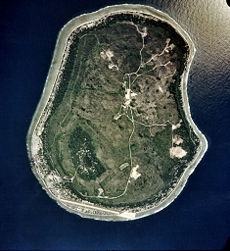
Nauru was one of three great phosphate rock islands in the Pacific Ocean (the others are Banaba (Ocean Island) in Kiribati and Makatea in French Polynesia); however, the phosphate reserves are nearly depleted. Phosphate mining in the central plateau has left a barren terrain of jagged limestone pinnacles up to 15 m (49 ft.) high. A century of mining has stripped and devastated four-fifths of the land area. Mining has also had an impact on the surrounding Exclusive Economic Zone with 40% of marine life considered to have been killed by silt and phosphate run off.[17]
There are limited natural fresh water resources on Nauru. Roof storage tanks collect rainwater, but islanders are mostly dependent on a single, aging desalination plant. Nauru's climate is hot and extremely humid year-round, because of the proximity of the land to the Equator and the ocean. The island is affected by monsoonal rains between November and February. Annual rainfall is highly variable and influenced by the El Niño-Southern Oscillation, with several recorded droughts.[3] The temperature ranges between 26 and 35 °C (79 and 95 °F) during the day and between 25 and 28 °C (77 and 82 °F) at night. As an island nation, Nauru may be vulnerable to climate and sea level change, but to what degree is difficult to predict; at least 80% of its land area of Nauru is well elevated, but this area will be uninhabitable until the phosphate mining rehabilitation program is implemented.[17]
There are only 60 recorded vascular plant species native to the island, none of which is endemic. Coconut farming, mining and introduced species have caused serious disturbance to the native vegetation.[3] There are no native land mammals; there are native birds, including the endemic Nauru Reed Warbler, insects and land crabs. The Polynesian Rat, cats, dogs, pigs and chickens have been introduced to the island.
Economy
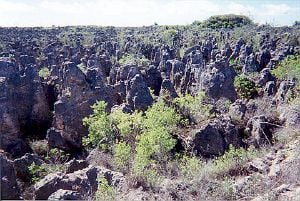
Nauru's economy depends almost entirely on declining phosphate deposits; there are few other resources, and most necessities are imported. [18] Small-scale mining is still conducted by the NPC. The government places a percentage of the NPC's earnings in the Nauru Phosphate Royalties Trust. The Trust manages long-term investments, intended to support the citizens once the phosphate reserves have been exhausted. However, a history of bad investments, financial mismanagement, overspending and corruption has reduced the Trust's fixed and current assets. For example, Nauru House in Melbourne was sold in 2004 to finance debts and Air Nauru's last Boeing 737-400 was repossessed in December 2005.[19][20] The value of the Trust is estimated to have shrunk from A$1,300 million in 1991 to A$138 million in 2002.[21] Nauru currently lacks money to perform many of the basic functions of government, the national Bank of Nauru is insolvent, and GDP per capita has fallen to US$5,000 per annum.
There are no personal taxes in Nauru, and the government employs 95% of those Nauruans who work; unemployment is estimated to be 90%.[22][1] The Asian Development Bank notes that although the administration has a strong public mandate to implement economic reforms, in the absence of an alternative to phosphate mining, the medium-term outlook is for continued dependence on external assistance.[21] The sale of deep-sea fishing rights may generate some revenue. Tourism is not a major contributor to the economy, because there are few facilities for tourists; the Menen Hotel and OD-N-Aiwo Hotel are the only hotels on the island.
In the 1990s, Nauru became a tax haven and offered passports to foreign nationals for a fee. It became a favourite spot for the dirty money of the Russian mafia. A no-questions-asked policy enabled an estimated US$70bn dollars of assets belonging to Russian gangsters to be funnelled to Nauru.[22] The inter-governmental Financial Action Task Force on Money Laundering (FATF) then identified Nauru as one of 15 "non-cooperative" countries in its fight against money laundering. Under pressure from FATF, Nauru introduced anti-avoidance legislation in 2003, following which foreign hot money flowed out of the country. In October 2005, this legislation—and its effective enforcement—led the FATF to lift the non-cooperative designation.[23]
Demographics
Of the island's 13,048 residents, 58% are Nauruan, 26% other Pacific Islanders, 8% Chinese and 8% Europeans.[1] The official language of Nauru is Nauruan, a distinct Pacific island language. English is widely spoken and is the language of government and commerce.
The main religion practised on the island is Christianity (two-thirds Protestant, one-third Roman Catholic). The Constitution provides for freedom of religion; however, the government restricts this right in some circumstances, and has restricted the practice of religion by the Church of Jesus Christ of Latter-day Saints and members of Jehovah's Witnesses, most of whom are foreign workers employed by the Nauru Phosphate Corporation.[24]
An increased standard of living since independence has had some negative effects on the population. Nauruans are among the most obese people in the world, with 90% of adults overweight.[25] Nauru has the world's highest level of type 2 diabetes, with more than 40% of the population affected.[26] Other significant diet-related problems on Nauru include renal failure and heart disease. Life expectancy has fallen to 58.0 years for males and 65.0 years for females.[27]
Literacy on the island is 97%, education is compulsory for children from six to 15 years of age (Years 1–10), and two non-compulsory years are taught (Years 11 and 12).[28] There is a campus of the University of the South Pacific on the island; before the campus was built, students travelled to Australia for their university education.
Culture
Nauruans descended from Polynesian and Micronesian seafarers who believed in a female deity, Eijebong, and a spirit land, an island called Buitani. Two of the 12 original tribal groups became extinct in the 20th century. Angam Day, held on October 26 celebrates the recovery of the Nauran population after the two world wars, both of which reduced the indigenous population to fewer than 1500. The displacement of the indigenous culture by colonial and contemporary, western influences is palpable. Little of the old customs have been preserved, although some forms of traditional music and arts and crafts, and some traditional methods of fishing are still practised.
There is no daily news publication, although there are several weekly or fortnightly publications, including the Bulletin, the Central Star News and The Nauru Chronicle. There is a state-owned television station, Nauru Television (NTV) which broadcasts programs from New Zealand, and there is a state-owned non-commercial radio station, Radio Nauru, which carries items from Radio Australia and the BBC.[29]
Australian rules football is the most popular sport in Nauru; there is an elite national league with seven teams. All games are played at the island's only stadium, Linkbelt Oval. Other sports popular in Nauru include softball, cricket, golf, sailing and soccer. Nauru participates in the Commonwealth and Summer Olympic Games, where it has been successful in weightlifting—Marcus Stephen has been a prominent medallist; he was elected to parliament in 2003.
A traditional activity is catching noddy birds when they return from foraging at sea. At sunset, men stand on the beach ready to throw their lasso at the incoming birds. The Nauruan lasso is supple rope with a weight at the end. When a bird approaches, the lasso is thrown up, hits and or drapes itself over the bird, and then falls to the ground. The captured noddies are cooked and eaten.[30]
See also
Template:Nauru topics
ReferencesISBN links support NWE through referral fees
- ↑ 1.0 1.1 1.2 1.3 CIA World Fact Book URL Accessed 2006-05-02
- ↑ 2.0 2.1 Republic of Nauru Permanent Mission to the United Nations URL Accessed 2006-05-10
- ↑ 3.0 3.1 3.2 Nauru Department of Economic Development and Environment. 2003. First National Report To the United Nations Convention to Combat Desertification (UNCCD) URL Accessed 2006-05-03
- ↑ McDaniel, C. N. and Gowdy, J. M. 2000. Paradise for Sale. University of California Press ISBN 0520222296 pp 13-28
- ↑ Ellis, A. F. 1935. Ocean Island and Nauru - their story. Angus and Robertson Limited. pp 29-39
- ↑ Ellis, A. F. 1935. Ocean Island and Nauru - their story. Angus and Robertson Limited. pp 127-139
- ↑ Agreement between Australia, New Zealand and United Kingdom regarding Nauru]
- ↑ Haden, J. D. 2000. Nauru: a middle ground in World War II Pacific Magazine URL Accessed 2006-05-05
- ↑ Garrett, J. 1996. Island Exiles. ABC. ISBN 0-7333-0485-0. pp176-181
- ↑ Highet, K and Kahale, H. 1993. Certain Phosphate Lands in Nauru. The American Journal of International Law 87:282-288
- ↑ 11.0 11.1 11.2 Australian Department of Foreign Affairs and Trade. Republic of Nauru Country Brief - November 2005 URL accessed on 2006-05-02. Cite error: Invalid
<ref>tag; name "DFAT" defined multiple times with different content Cite error: Invalid<ref>tag; name "DFAT" defined multiple times with different content - ↑ Gordon, M. November 5, 2005. Nauru's last two asylum seekers feel the pain. The Age URL Accessed 2006-05-08
- ↑ Ogden, M.R. Republic of Nauru URL Accessed 2006-05-02.
- ↑ Nauru (High Court Appeals) Act (Australia) 1976. Australian Legal Information Institute URL Accessed 2006-08-07
- ↑ State Department Bureau of East Asian and Pacific Affairs September 2005 URL Accessed 2006-05-11
- ↑ AAP. May 14 2005. Taiwan Re-establishes Diplomatic Ties with Nauru URL Accessed 2006-05-05
- ↑ 17.0 17.1 17.2 Republic of Nauru. 1999. Climate Change Response Under the United Nations Framework Convention on Climate Change URL Accessed 2006-05-03
- ↑ Big tasks for a small island URL Accessed 2006-05-10
- ↑ McAloon. C. April 18, 2004. Receivers take over Nauru House. The Age URL Accessed 2006-05-09
- ↑ Air Naru flight Schedule URL Accessed 2006-05-02.
- ↑ 21.0 21.1 Asian Development Bank. 2005. Asian Development Outlook 2005 - Nauru URL Accessed 2006-05-02
- ↑ 22.0 22.1 "Paradise well and truly lost", The Economist, 20 December 2001 URL Accessed 2006-05-02.
- ↑ FATF. October 13, 2005. Nauru de-listed URL Accessed 2006-05-11
- ↑ US Department of State. 2003. International Religious Freedom Report 2003 - Nauru URL Accessed 2005-05-02.
- ↑ Obesity in the Pacific: too big to ignore. 2002. Secretariat of the Pacific Community ISBN 982-203-925-5
- ↑ King, H. and Rewers M. 1993. Diabetes in adults is now a Third World problem. World Health Organization Ad Hoc Diabetes Reporting Group. Ethnicity & Disease 3:S67-74.
- ↑ WHO The world health report 2005. Nauru URL Accessed 2006-05-02
- ↑ Waqa, B. 1999. UNESCO Education for all Assessment Country report 1999 Country: Nauru URL Accessed 2006-05-02.
- ↑ BBC News. Country Profile: Nauru. URL Accessed 2006-05-02.
- ↑ Banaba/Ocean Island News. URL Accessed 2006-05-11.
This article incorporates public domain text from the websites of the United States Department of State & CIA World Factbook.
External links
- Open Directory Project - Nauru directory category
- Nauru, Permanent Mission to the United Nations
- Radio program "This American Life" featured a 30-minute story on Nauru
- Air Nauru
- Air Nauru Flight Schedule
- CenPac - The ISP of the Republic of Nauru
- high resolution aerial views of Nauru on Google Maps
| Countries and territories of Oceania | |
| Australia : Australia · Norfolk Island | |
| Melanesia : East Timor · Fiji · Maluku Islands & Western New Guinea (part of Indonesia) · New Caledonia · Papua New Guinea · Solomon Islands · Vanuatu | |
| Micronesia : Guam · Kiribati · Marshall Islands · Northern Mariana Islands · Federated States of Micronesia · Nauru · Palau · Wake Island | |
| Polynesia : American Samoa · Cook Islands · French Polynesia · Hawaii · New Zealand · Niue · Pitcairn Islands · Samoa · Tokelau · Tonga · Tuvalu · Wallis and Futuna | |
Template:Former German colonies
af:Nauru
als:Nauru
ar:ناورو
an:Nauru
zh-min-nan:Nauru
bn:নাউরু
bs:Nauru
bg:Науру
ca:Nauru
cs:Nauru
da:Nauru
de:Nauru
et:Nauru
el:Ναουρού
es:Nauru
eo:Nauro
eu:Nauru
fr:Nauru
fy:Naurû
gl:Nauru - Naoero
ko:나우루
hr:Nauru
io:Nauru
id:Nauru
ia:Nauru
is:Nárú
it:Nauru
he:נאורו
ka:ნაურუ
ks:Nauru
kw:Nauru
ht:Naorou
la:Naurum
lv:Nauru
lb:Nauru
lt:Nauru
li:Naoeroe
hu:Nauru
mi:Nauru
mr:नौरू
ms:Nauru
na:Naoero
nl:Nauru
ja:ナウル
no:Nauru
nn:Nauru
oc:Nauru
nds:Nauru
pl:Nauru
pt:Nauru
ro:Nauru
rm:Nauru
ru:Науру
se:Nauru
sq:Naurua
scn:Nauru
simple:Nauru
sk:Nauru
sl:Nauru
sr:Науру
fi:Nauru
sv:Nauru
tl:Nauru
th:สาธารณรัฐนาอูรู
vi:Nauru
tr:Nauru
uk:Науру
zh:瑙鲁
Credits
New World Encyclopedia writers and editors rewrote and completed the Wikipedia article in accordance with New World Encyclopedia standards. This article abides by terms of the Creative Commons CC-by-sa 3.0 License (CC-by-sa), which may be used and disseminated with proper attribution. Credit is due under the terms of this license that can reference both the New World Encyclopedia contributors and the selfless volunteer contributors of the Wikimedia Foundation. To cite this article click here for a list of acceptable citing formats.The history of earlier contributions by wikipedians is accessible to researchers here:
The history of this article since it was imported to New World Encyclopedia:
Note: Some restrictions may apply to use of individual images which are separately licensed.

